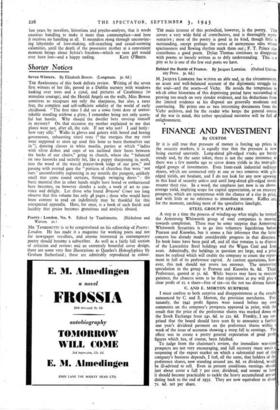FINANCE AND INVESTMENT
By CUSTOS
IF it is still true that pressure of money is forcing up prices in the security markets, it is equally true that the pressure is now being exerted unevenly. Long-dated gilt-edged socks are barely steady and, by the same token, there is not the same insistence as there was a few months ago to screw down yields in the near-gilt- edged groups of investments. Even front-rank industrial ordinary shares, which are connected only at one or two removes with gilt- edged yields, are hesitant, and I do not look for any- new upswing in this kind of security unless and until long-dated gilt-edged stocks resume -their rise. In a word, the emphasis just now is on above- average yield, implying scope for capital appreciation, or on recovery prospects, which are synonymous with the chance of a rise in price, and with little or no reference to immediate income. Kaffirs are, for the moment, catching most of the speculative limelight.
STEEL GROUP'S AFFAIRS A step at a time the process of winding-up what might be termed the Armstrong Whitworth 'group of steel companies is moving towards completion. There may be some surprise that Armstrong Whitworth Securities is to go into voluntary liquidation 'before Pearson and Knowles, but it seems a fair inference that the latter concern has already made considerable progress in that direction. Its bank loans have been paid off, and all that remains is to dispose of the Lancashire Steel holdings and the Wigan Coal and Iron asset. Admittedly, the holdings in question are large, and a price must be realised which will enable the company to count the repay- ment in full of its preference capital. At current quotations, how- ever, this task should not move too onerous. The interesting speculation in the group is Pearson and Knowles 6s. 8d. Third Preference, quoted at 5s. 6d. While buyers may have to exercise patience, the chances seem to be that repayment at par will give a clear profit of Is. a share—free of tax—in the not too distant future.
C. AND E. MORTON SURPRISE
I must confess to both surprise and disappointment at the results announced by C. and E. Morton, the provision merchants. For- tunately, the 1942 profit figures were issued before my own comments on the company's prospects appeared in print, with the result that the price of the preference shares was marked down on the Stock Exchange from 24s. 6d. to 22s. 6d. Frankly, I am sur- prised that the board should have seen fit to announce a further one year's dividend payment on the preference shares within a week of the issue of accounts showing a steep fall in earnings. The effect was to create a pretty general expectation of good profit figures which has, of course, been falsified.
To judge from the chairman's review, the immediate war-time prospects are not very encouraging, and full recovery must await a
reopening of the export market on which a substantial part of this company's business depends. I feel, all the same, that holders of th preference shares, now standing around 2os. 6d. ex dividend, woul be ill-advised to sell. Even in present conditions earnings shou just about cover a full 7 per cent. dividend, and sooner or late it should become practicable to tackle the heaVy accumulated arre dating back to the end of 1932. They are now equivalent to ahou 7s. 6d. net -per share. Among the post-war recovery shares carrying arrears of dividend which are already steadily progressing towards their goal are the 5 per cent. First Lx and the 71 per cent. Second LI Preferred Ordinaries of John Lewis Partnership. In both cases- the arrears date back to December, 1939, so that by the end of this year they will be equivalent to 2S. net on the 5 per cent. and 3s. net on the 71 per cent. stock. The strength of the position is that John Lewis and Co., on which the Partnership depends for its income through a large holding in the ordinary capital, is now making good progress in clearing off its own preference arrears. Payments on the Second Preferences have already been brought up to July, 1942, and I shall be surprised if pext year the slate is not clean. That will open the way for a resumption of ordinary dividends, which, in pre-war years, ranged between 8 per cent. and 12 per cent. Total issued 5 per cent. Preferred Ordinary stock of the Partnership amounts to £300,000, giving an annual net dividend charge of only L7,5oo, or £30,000 for the four years to the end of 1943. It should be possible, therefore, to clear off these arrears fairly quickly when John Lewis and Co. resumes ordinary distributidns. The Parmership's 5 per cent. First Preferred shares at 16s. 9d. and the Seconds around 18s. should .both prove good lock-up investments.



























 Previous page
Previous page